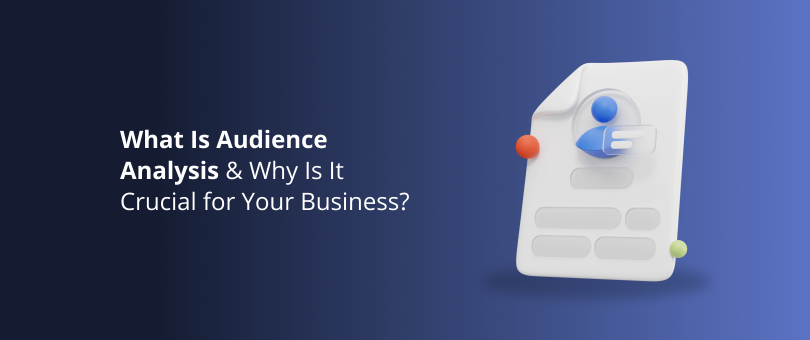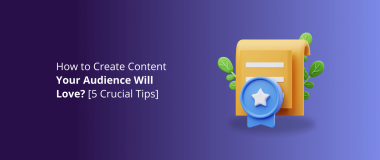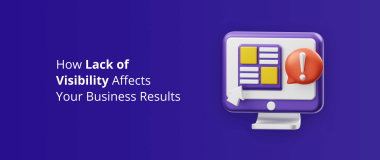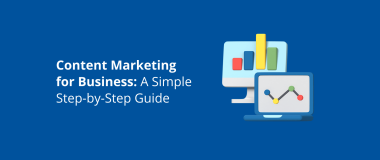You have invested a lot of time and effort into creating an awesome product. But get this straight: it doesn’t matter.
It doesn’t matter how great your product is if you aren’t selling it to the right audience, you’ll never be successful.
If you want your business to succeed, you need to understand who your audience is and give them what they need.
Let us learn more about audience analysis and its specifics.
Readers Also Enjoy: How to Create Content Your Audience Will Love? [5 Crucial Tips] – DevriX
What Is Audience Analysis?
Audience analysis is a way of obtaining information about the people who follow you, and understanding their needs, values, goals, attitudes, etc.
It is important to understand that this analysis should be preceded by the process of defining your target audience.
Establish the demographics (gender, age, location), and psychographics (personality, interests, opinions) of your audience, and from there you can narrow things down to a single group, which you can analyze in depth.
Readers Also Enjoy: The Complete Guide to Finding Your Target Market + Infographic – DevriX
Types of Audience Analysis
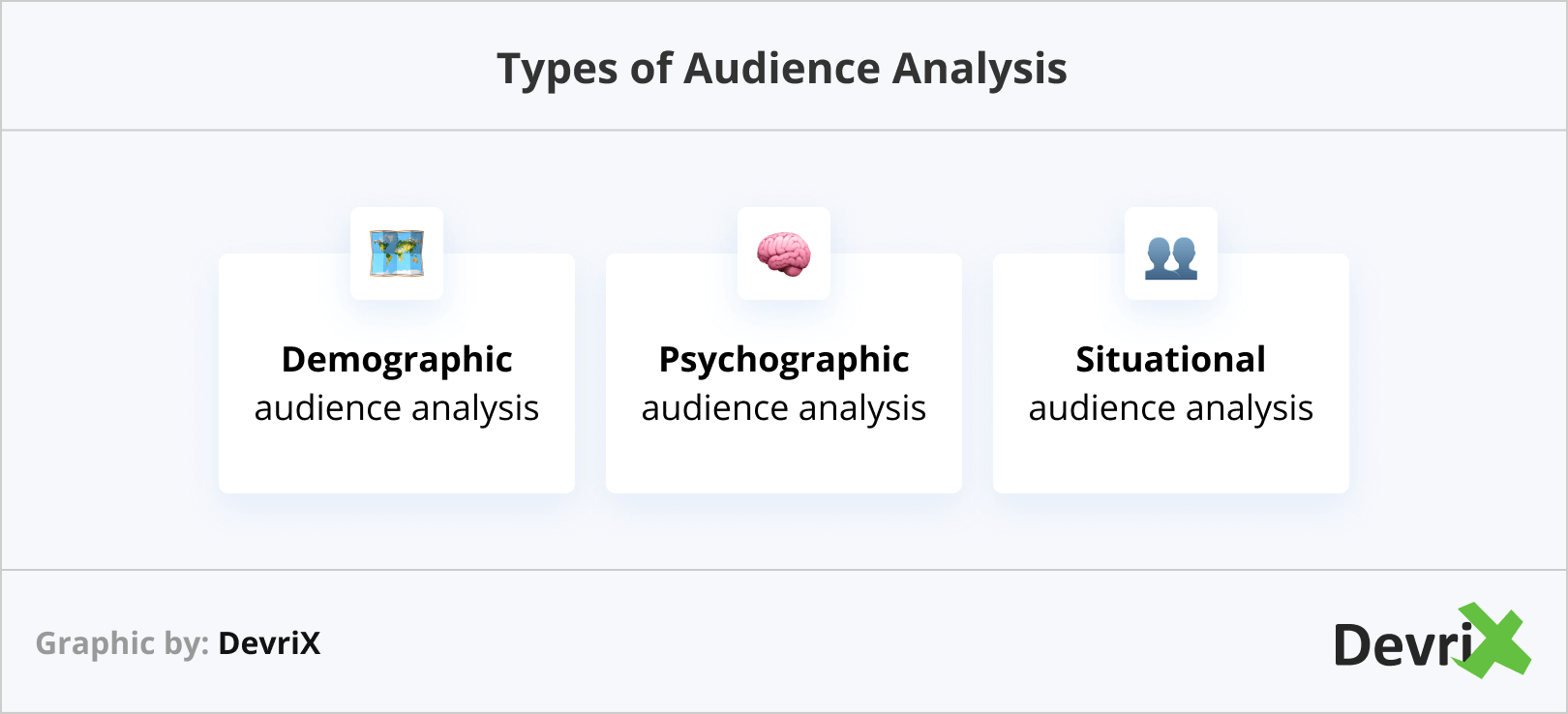
In general, there are three types of audience analysis:
- Demographic audience analysis. Analyze the demographic data of your audience, like age, gender, marital status, ethnicity, race, social status, and so on. Doing a demographic audience analysis reveals a lot of useful information about your users. The best part is that there are a lot of tools you can use like GA4, Google Ads, Facebook Ads, and so on.
- Psychographic audience analysis. Unlike demographics, which is pretty straightforward and easy to understand, psychographic data requires a more thorough analysis. This is because psychographic data includes factors like interests, values, and beliefs, which are much harder to obtain and understand. For example, two individuals might say that they live a healthy lifestyle, but that can mean different things, depending on how they interpret it.
- Situational audience analysis. Situational analysis includes the size of the audience, their attitude towards your product and company, their prior knowledge, and your website/social media channels.
Readers Also Enjoy: How to Drive Traffic to Your Website Using Social Media [11 Tips] – DevriX
How to Do An Audience Analysis in 5 Easy Steps

- Choose a Tool for Audience Analysis
- Select the Questions to Ask
- Pick an Audience Type
- Create an Audience Report
- Analyze Data to Answer Your Questions
1. Choose a Tool for Audience Analysis
The first step in your audience analysis process is to select the tools you want to use. Luckily, there are a lot of tools available to choose from, including some free ones.
Perhaps the most famous one is Google Analytics, but practically every social media platform has some kind of data tool. So, ultimately, select the audience research tool of your liking, get familiar with it, and use it to get insights and data on your audience.
Readers Also Enjoy: 43+ Best Tools for Successful Content Marketing – DevriX
2. Select the Questions to Ask
After that, you need to determine the specific goals you want to achieve from your audience analysis. To do that, you need to clarify the questions you will ask.
This way your analysis will be much more focused, and you will have a clear objective, instead of just asking tons of questions, without being sure about their purpose.
Readers Also Enjoy: 24 Sales Qualifying Questions to Up Your Sales Game – DevriX
3. Pick an Audience Type
Depending on the questions you have selected, you need to establish a common factor, which will serve as a guideline when creating your audience.
For example, if it is a branded audience, you will need to use a brand account, your list of customers, or even that of a competitor.
In the opposite scenario, when it is not a branded audience, you will probably need to use a keyword, hashtag, or a specific attribute, like a job role to discover the appropriate people for your analysis.
Readers Also Enjoy: How to Use Sponsored Content Without Annoying Your Audience – DevriX
4. Create an Audience Report
Finally, it is time to create your audience report. The process may vary depending on the tool you have decided to use.
Some are easy-to-use, creating automatically generated reports, while others require a bit more manual adjustment.
Either way, once you have completed the set-up, you can start the essential part of the process.
Readers Also Enjoy: A Step-by-Step Guide to Creating a Funnel Report with Google Analytics – DevriX
5. Analyze Data to Answer Your Questions
At last, you have a detailed data report that contains a lot of information. Invest some time in understanding the report, but also remember not to get too distracted from the initial goal you have set for yourself.
Remember the questions you wanted to answer initially, try to find their answers, and use the knowledge you have gained from the report to your advantage.
You can repeat this same process for any additional questions or goals you may have.
Readers Also Enjoy: How to Leverage Data-Driven Decision Making for Business Growth – DevriX
6 Ways to Use Data from Your Audience Analysis
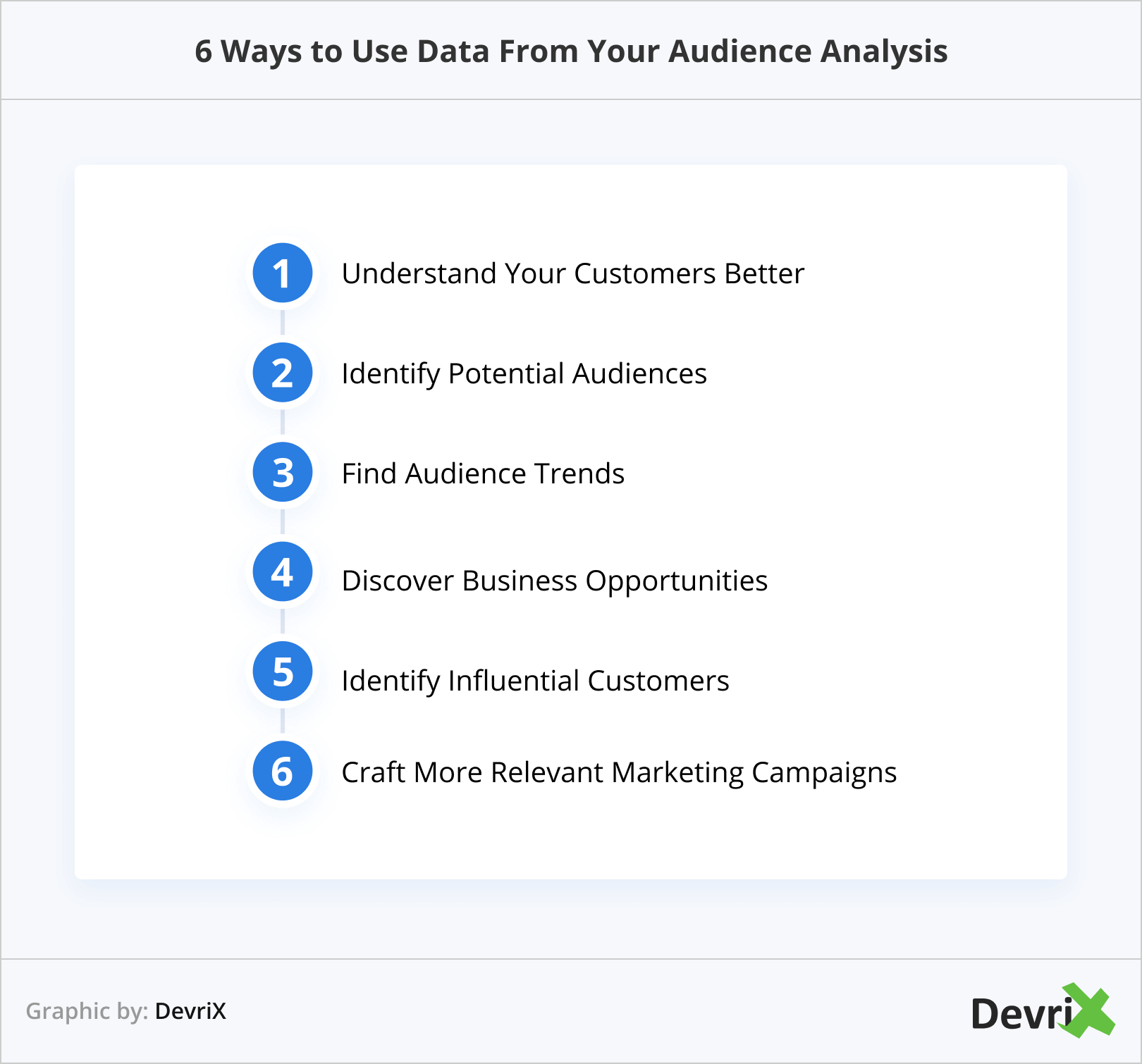
- Understand Your Customers Better
- Identify Potential Audiences
- Find Audience Trends
- Discover Business Opportunities
- Identify Influential Customers
- Craft More Relevant Marketing Campaigns
1. Understand Your Customers Better
Why is an audience analysis important? The answer is very simple – it allows you to understand your customers better.
Think about their geographic locations, gender, age groups, interests, values, etc. All these insights can be invaluable when determining the target audience of your business, and what they actually care about.
From thereon, you can think about ways to provide personalized offers, and deliver a better user experience.
Readers Also Enjoy: Customer Intelligence 101: Your Guide to Winning the Customer’s Heart – DevriX
2. Identify Potential Audiences
Aside from the fact you will be able to develop your relationship with existing customers, you can also identify new, potential customers.
Analyzing the data can give insights into user profiles that are similar to the ones of your existing customers.
On top of that, you will be able to understand your competitors’ audience, too.
Readers Also Enjoy: 6 Infallible Ways to Research Your Competitors and Determine Their Strategies – DevriX
3. Find Audience Trends
Trending things always drive sales. But how do you know what trends your customers are following? Easy. Take a look at the data.
You just need to spot the patterns in the behavior of your customers, and adjust your strategy accordingly. This way you can stay on top of the latest trends, and gain a competitive advantage over your competitors.
Readers Also Enjoy: How to Find Trending Topics Online? [Tips & Tools] – DevriX
4. Discover Business Opportunities
It is possible that in your data you’ve noticed common problems that your audience has had. Perhaps, they need a product or service that is not currently available on the market?
This is where you can shine. Creating a product/service that fills a gap, or adding a new feature to your existing ones, could possibly result in more sales, and happier customers.
Readers Also Enjoy: How to Boost Your Reputation with Industry Research – DevriX
5. Identify Influential Customers
You might notice that a lot of your customers are following the same online personalities. Learning who or what influences your customer-base is not something you should ignore.
Quite the opposite, using this knowledge, you can understand what users like, and therefore what type of content your audience is most likely to enjoy.
What is more, if you can identify the influencers your clients follow, you will be able to better tailor your influencer marketing campaigns.
Readers Also Enjoy: How to Create Original Content And Win Readers? – DevriX
6. Craft More Relevant Marketing Campaigns
Irrelevant marketing offers quickly get deleted or totally ignored. When that happens, all your marketing efforts are in vain.
Luckily, with data from audience analysis, you can target your current and potential clients effectively, be it with ads, content, or social media.
By being able to comprehend how your audience thinks, what it likes, and what their interests are, you can craft more effective and relevant marketing messages.
Readers Also Enjoy: Advertising Trends: Tactics to Implement in 2023 – DevriX
Conclusion
Understanding what audience analysis is good, but it is even more important to realize how you can use the data insights to provide a better user experience to your customers.
Let us not forget that no matter how much time and effort you invest in your product, it will all be for nothing, if you are not targeting the right people with the right messages.
Ultimately, do not hesitate to use audience analysis to your advantage. It can allow you to identify what your clients like, what they want, and what they need. That is key for running a successful business.
